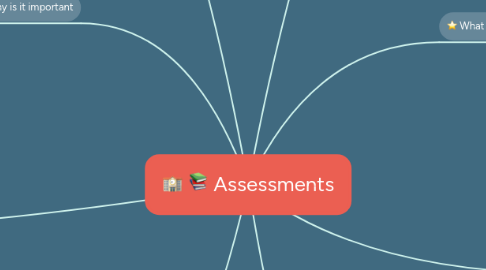
1. Formative
1.1. Definition
1.1.1. Process of gathering evidence of student learning.
1.2. Characteristics
1.2.1. Instruction adjustments
1.2.2. Structure
1.2.3. Participants involved feedback
1.2.4. Evidence of student learning
1.2.5. Teacher-student interaction
1.2.6. Attributions for success
1.3. Informal Formative Assessment
1.3.1. Informal observations
1.3.2. Questioning
1.3.3. Spontaneous
1.3.4. Immediate feedback and instructional adjustments
1.4. Formal Formative Assessment
1.4.1. Structured exercises
1.4.2. Pretests
1.4.3. homework
1.4.4. In class assignments
1.4.5. Quizzes and unit tests
1.4.6. Classroom response systems
2. Performance
2.1. Definition
2.1.1. Also known as authentic assessment, is a form of testing that requires students to perform task rather than select and answer from a ready-made list.
2.2. How?
2.2.1. Indivual
2.2.2. Groups
2.3. Types
2.3.1. Projects
2.3.2. Portfolios
2.3.3. Student logs
2.3.4. Journals
3. Diagnostic
3.1. Definition
3.1.1. A form of pre-assessment that allows a teacher to determine students individual strengths, weaknesses, knowledge, and skills prior to instruction.
3.2. Purpose
3.2.1. Used to diagnose student difficulties and to guide lesson and curriculum planning
3.3. When?
3.3.1. Before teaching or when a problem arises
4. Why is it important
4.1. Help students learn
4.2. Teachers improve instruction
4.3. Administrators decide how to allocate resources
4.4. Policymakers evaluate the efficacy of education programs
5. Summative
5.1. Definition
5.1.1. Used to evaluate student learning, skill acquisition, and academic achievement at the end of an instructional period.
5.2. Planning Summative Assessments
5.2.1. End of large chunk of learning
5.2.2. Review what you want to do
5.2.3. Criteria for ensuring high-quality assessment
5.2.4. Representative sampling
5.2.5. Standardized testing, final exams, major cumulative projects, research projects, etc.
5.3. Preparing Students
5.3.1. Teach assessment taking skills
5.3.2. Test length, format, types of questions
5.3.3. Review
5.3.4. Item type and format
5.3.5. Assessment anxiety
5.4. Conducting/Creating Summative Assessments
5.4.1. When should they be scheduled
5.4.2. When should they be created
5.4.3. Assessment directions
5.4.4. Arrange items
5.4.5. Physical layout
5.5. Purpose
5.5.1. Report cards
5.5.2. District and state reports
6. Interim/Benchmark
6.1. Definition
6.1.1. Evaluation of where students are in their learning process and to determine whether they are on track to performing well on future assessments.
6.2. When?
6.2.1. Periodic testing throughout the school year
6.2.2. E.g. every six weeks or chapter test
6.3. Characteristics
6.3.1. Low-level
6.3.2. Little or no student feedback
6.3.3. A formal style using projects, written assignments, and test
6.4. Purpose
6.4.1. Adjust instruction
6.4.2. Report cards
6.4.3. District reports

